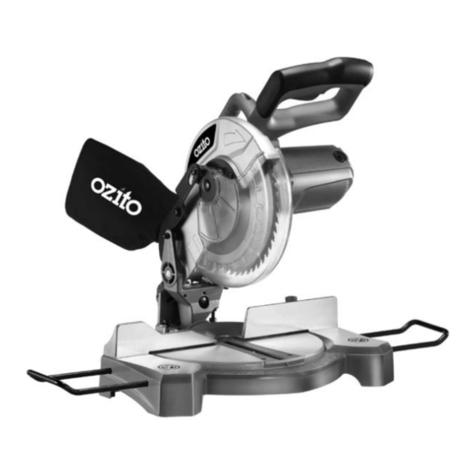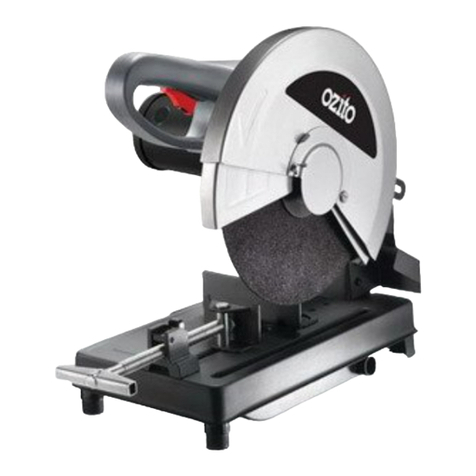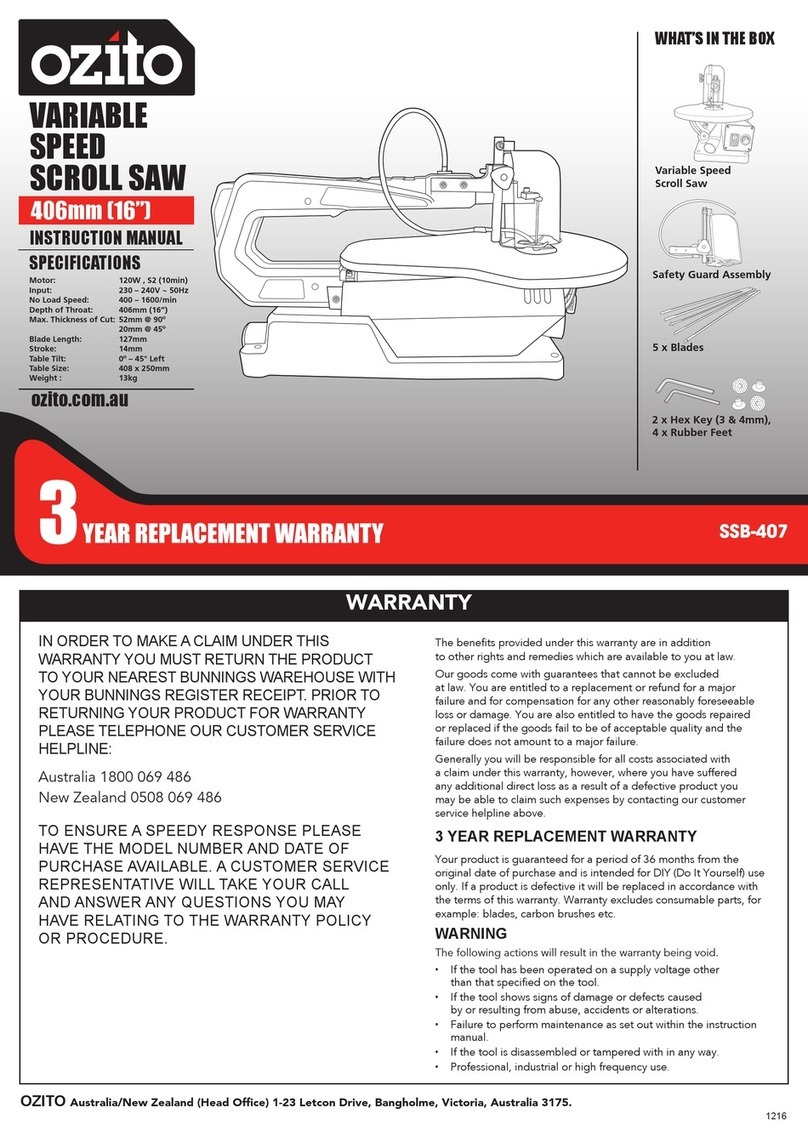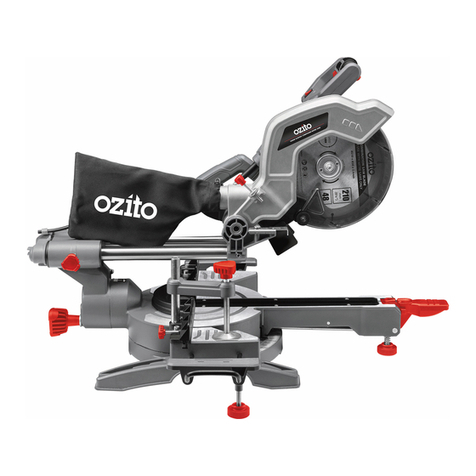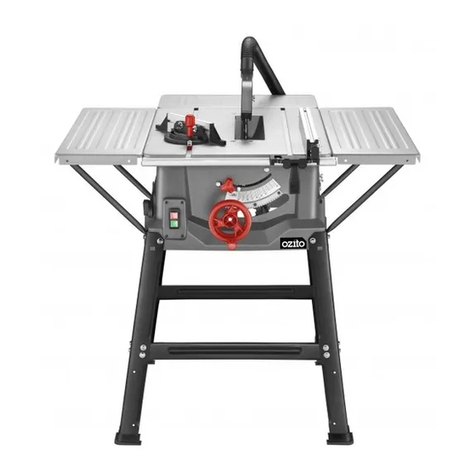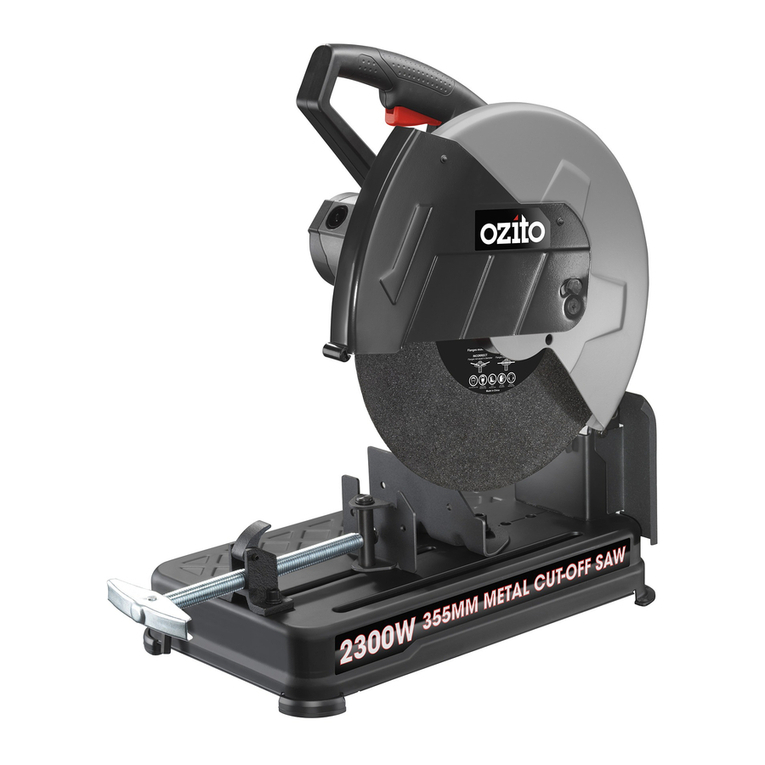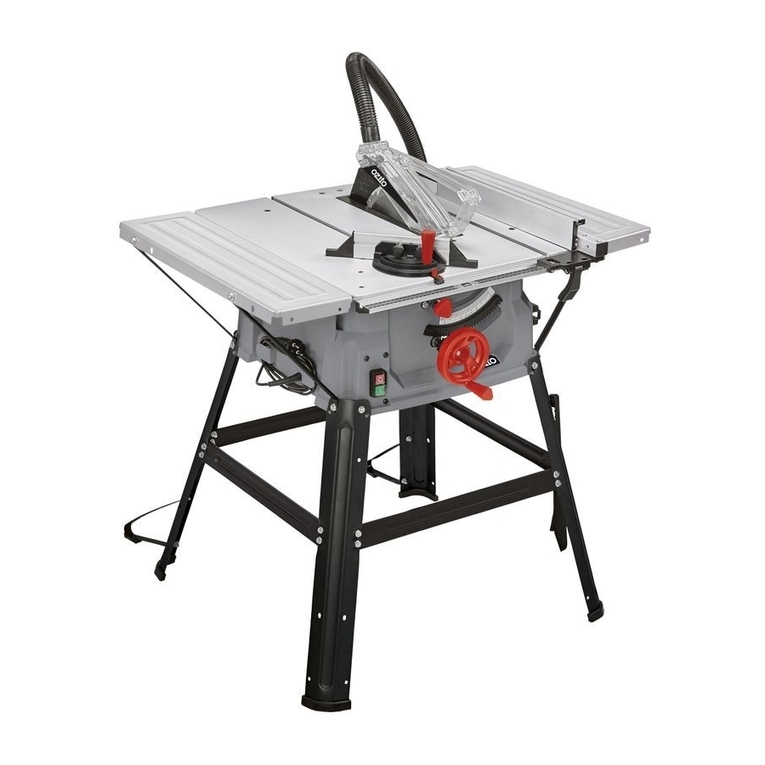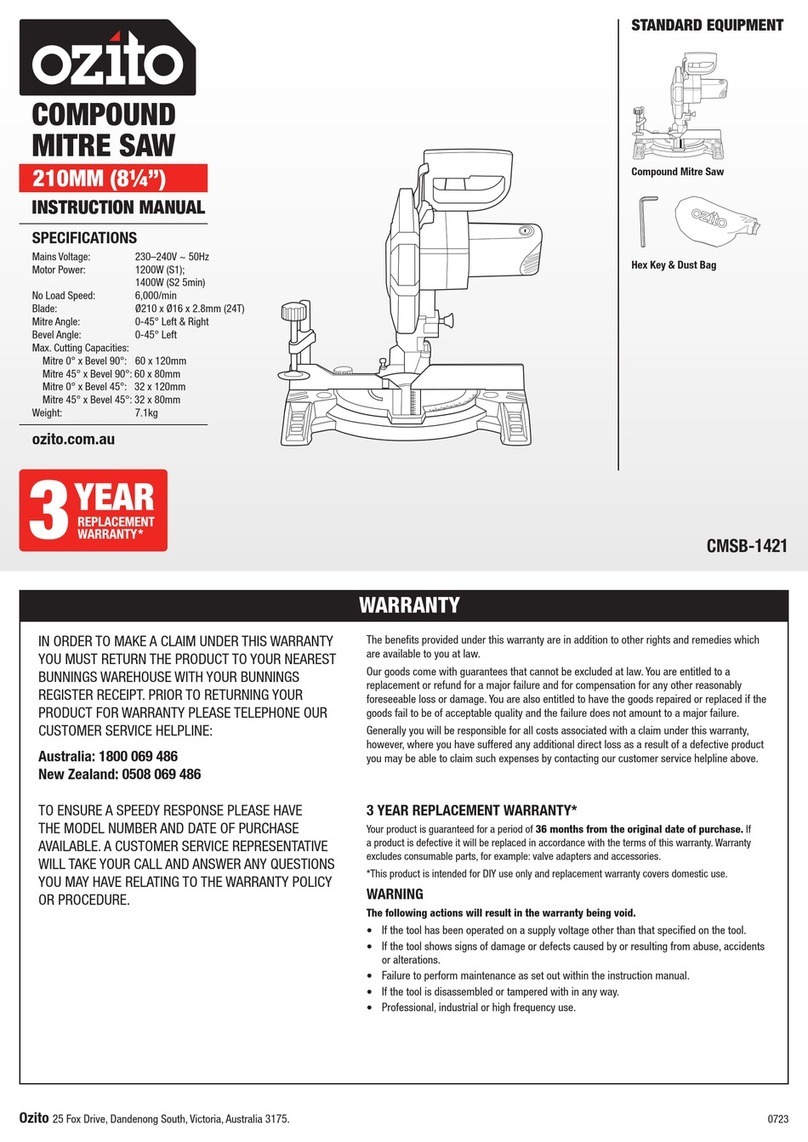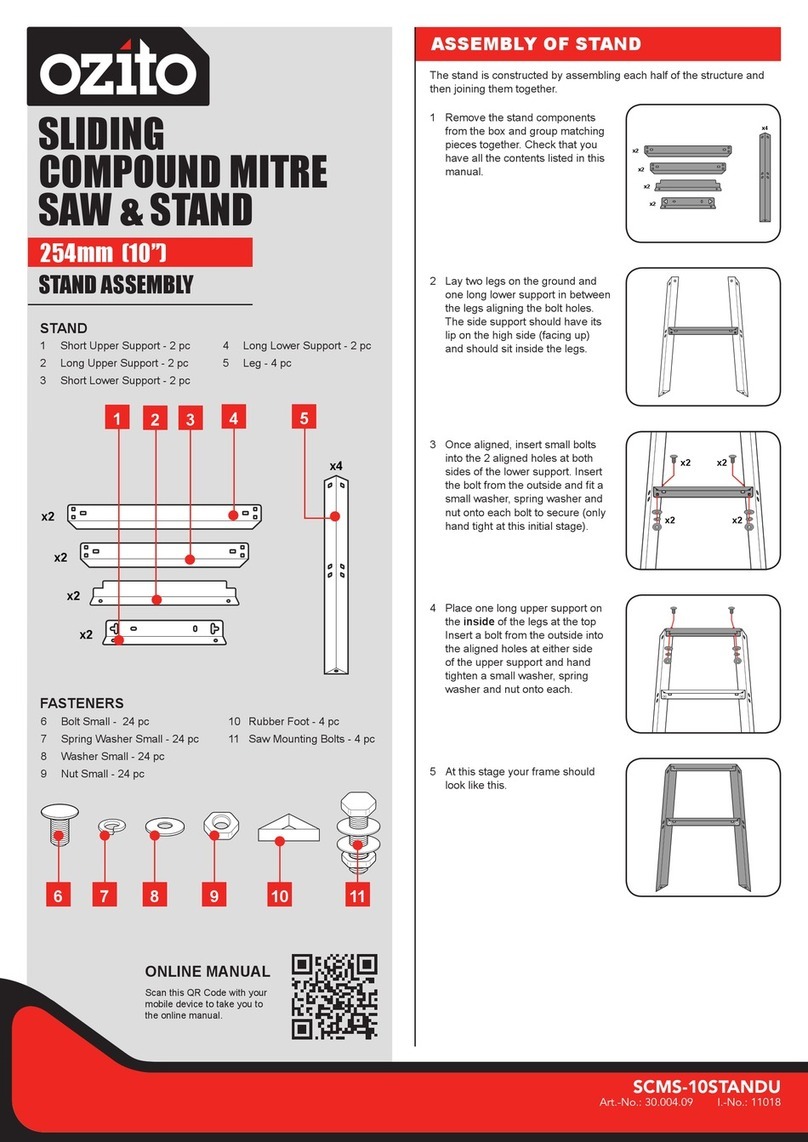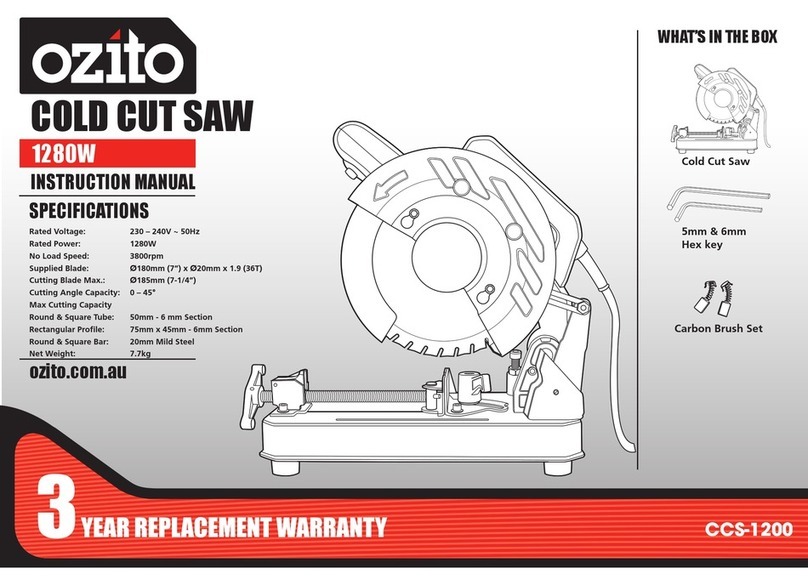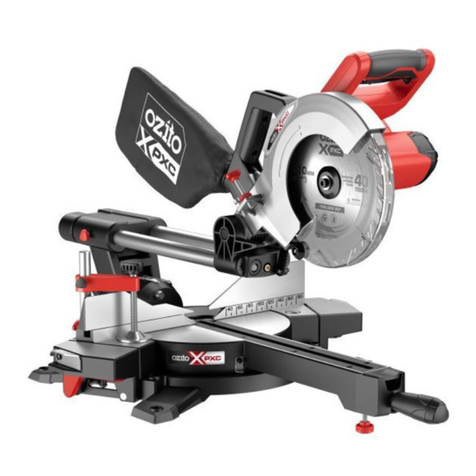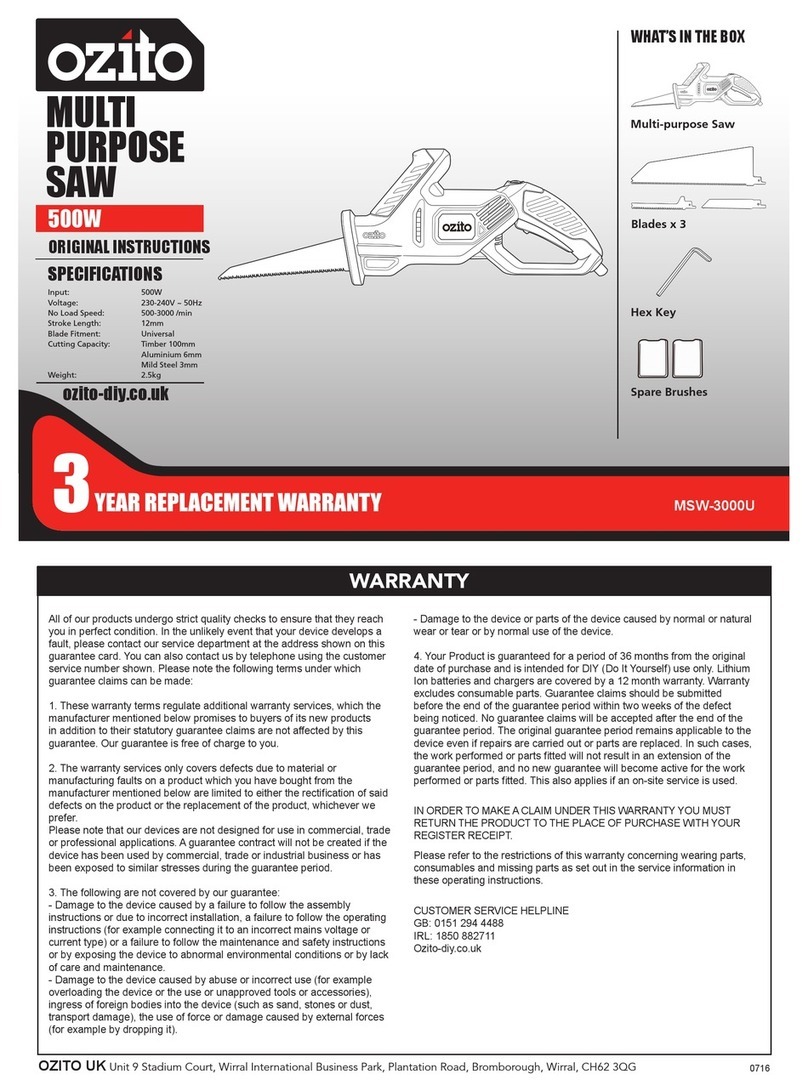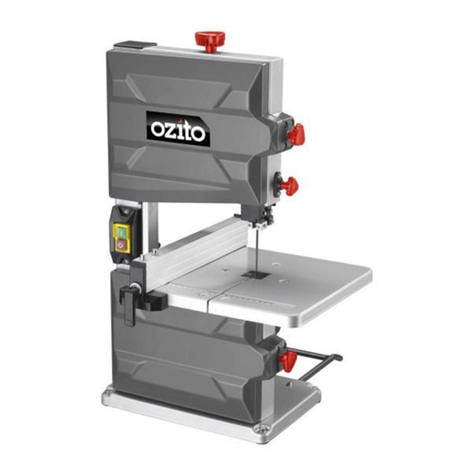
WARNING! When using mains-powered tools, basic safety precautions, including the following, should always be
followed to reduce risk of fire, electric shock, personal injury and material damage.
Read the whole manual carefully and make sure you know how to switch the tool off in an emergency, before
operating the tool.
Save these instructions and other documents supplied with this tool for future reference.
This tool has been designed for 230V and 240V only. Always check that the power supply corresponds to the voltage on the
rating plate.
Note: The supply of 230V and 240V on Ozito tools are interchangeable for Australia and New Zealand.
This tool is double insulated; therefore no earth wire is required.
Note: Double insulation does not take the place of normal safety precautions when operating this tool. The insulation
system is for added protection against injury resulting from a possible electrical insulation failure within the tool.
Using an Extension Lead
Always use an approved extension lead suitable for the power input of this tool. Before use, inspect the extension lead for signs
of damage, wear and ageing. Replace the extension lead if damaged or defective.
When using an extension lead on a reel, always unwind the lead completely. Use of an extension lead not suitable for the power
input of the tool or which is damaged or defective may result in a risk of fire and electric shock.
The power supply for this product should be protected by a residual current device (rated at 30mA or less). A residual current
device reduces the risk of electric shock.
WARNING! The appliance is not to be used by persons (including children) with reduced physical, sensory
or mental capabilities, or lack of experience and knowledge, unless they have been given supervision or
instruction. Young children should be supervised to ensure that they do not play with the appliance. Before
connecting a tool to a power source (mains switch power point receptacle, outlet, etc.) be sure that the voltage supply is the
same as that specified on the nameplate of the tool. A power source with a voltage greater than that specified for the tool can
result in serious injury to the user, as well as damage to the tool. If in doubt, do not plug in the tool. Using a power source with a
voltage less than the nameplate rating is harmful to the motor.
• This tool is designed to cut timber products only. Do not use the tool to cut any other materials. Do not cut firewood with
this tool. The irregular shape of firewood makes it unsafe to cut with this tool.
• Blade depth and bevel adjusting locking levers must be tight and secure before making a cut. If blade adjustment shifts
while cutting, it may cause binding and kickback. Ensure all clamps, levers and locking knobs are securely tightened prior
to operation. This will result in projects being produced accurately and safely.
• When the blade binds in material being cut, switch off the tool and wait for blade to come to a complete stop. Investigate
and take corrective action to eliminate cause of binding.
• Do not use the saw to perform rebate or groove cuts unless suitable guarding, such as tunnel guard, is fitted above the
saw table. Do not use the saw for slotting (stopped groove) cuts.
• Use only transportation devices and never use the cuttings guards for handling or transportation when transporting the
machine. Always ensure the blades are covered by the blade guard during transportation.
Guarding related warnings
• Keep guards in place. Guards must be in working order and be properly mounted. A guard that is loose, damaged, or is not
functioning correctly must be repaired or replaced.
• Always use saw blade guard and riving knife for every through-cutting operation. For through-cutting operations where
the saw blade cuts completely through the thickness of the workpiece, the guard and other safety devices help reduce the
risk of injury.
• Make sure the saw blade is not contacting the guard, riving knife or the workpiece before the switch is turned on.
Inadvertent contact of these items with the saw blade could cause a hazardous condition.
• Adjust the riving knife as described in this instruction manual. Incorrect spacing, positioning and alignment can make the
riving knife ineffective in reducing the likelihood of kickback.
• For the riving knife device to work, it must be engaged in the workpiece. The riving knife is ineffective when cutting
workpieces that are too short to be engaged with the riving knife. Under these conditions a kickback cannot be prevented
by the riving knife.
• Use the appropriate saw blade for the riving knife. For the riving knife to function properly, the saw blade diameter must
match the appropriate riving knife and the body of the saw blade must be thinner than the thickness of the riving knife and
the cutting width of the saw blade must be wider than the thickness of the riving knife.
Cutting procedures warnings
• Danger: Never place your fingers or hands in the vicinity or in line with the saw blade. A moment of inattention or a slip
could direct your hand towards the saw blade and result in serious personal injury
• Feed the workpiece into the saw blade only against the direction of rotation. Feeding the workpiece in the same direction
that the saw blade is rotating above the table may result in the workpiece, and your hand, being pulled into the saw blade.
• Never use the mitre gauge to feed the workpiece when ripping and do not use the rip fence as a length stop when cross
cutting with the mitre gauge. Guiding the workpiece with the rip fence and the mitre gauge at the same time increases the
likelihood of saw blade binding and kickback.
• When ripping, always apply the workpiece feeding force between the fence and the saw blade. Use a push stick when the
distance between the fence and the saw blade is less than 150mm, and use a push block when this distance is less than
50mm. “Work helping” devices will keep your hand at a safe distance from the saw blade.
• Use only the push stick provided by the manufacturer or constructed in accordance with the instructions. This push stick
provides sufficient distance of the hand from the saw blade.
• Never use a damaged or cut push stick. A damaged push stick may break causing your hand to slip into the saw blade.
• Do not perform any operation “freehand”. Always use either the rip fence or the mitre gauge to position and guide the
workpiece. “Freehand” means using your hands to support or guide the workpiece, in lieu of a rip fence or mitre gauge.
Freehand sawing leads to misalignment, binding and kickback.
• Never reach around or over a rotating saw blade. Reaching for a workpiece may lead to accidental contact with the moving
saw blade.
• Provide auxiliary workpiece support to the rear and/or sides of the saw table for long and/or wide workpieces to keep them
level. A long and/or wide workpiece has a tendency to pivot on the table’s edge, causing loss of control, saw blade binding
and kickback.
• Feed workpiece at an even pace. Do not bend or twist the workpiece. If jamming occurs, turn the tool off immediately,
unplug the tool then clear the jam. Jamming the saw blade by the workpiece can cause kickback or stall the motor.
• Do not remove pieces of cut-off material while the saw is running. The material may become trapped between the fence
or inside the saw blade guard and the saw blade pulling your fingers into the saw blade. Turn the saw off and wait until the
saw blade stops before removing material.
• Use an auxiliary fence in contact with the table top when ripping workpieces less than 2mm thick. A thin workpiece may
wedge under the rip fence and create a kickback.
Kickback causes and related warnings
Kickback is a sudden reaction of the workpiece due to a pinched, jammed saw blade or misaligned line of cut in the workpiece with
respect to the saw blade or when a part of the workpiece binds between the saw blade and the rip fence or other fixed object. Most
frequently during kickback, the workpiece is lifted from the table by the rear portion of the saw blade and is propelled towards the
operator. Kickback is the result of saw misuse and/or incorrect operating procedures or conditions and can be avoided by taking
proper precautions as given below.
• Never stand directly in line with the saw blade. Always position your body on the same side of the saw blade as the fence.
Kickback may propel the workpiece at high velocity towards anyone standing in front and in line with the saw blade.
• Never reach over or in back of the saw blade to pull or to support the workpiece. Accidental contact with the saw blade
may occur or kickback may drag your fingers into the saw blade.
• Never hold and press the workpiece that is being cut off against the rotating saw blade. Pressing the workpiece being cut
off against the saw blade will create a binding condition and kickback.
• Align the fence to be parallel with the saw blade. A misaligned fence will pinch the workpiece against the saw blade and
create kickback.
• Use a featherboard to guide the workpiece against the table and fence when making non-through cuts such as rebating or
resawing cuts. A featherboard helps to control the workpiece in the event of a kickback.
• Support large panels to minimise the risk of saw blade pinching and kickback. Large panels tend to sag under their own
weight. Support(s) must be placed under all portions of the panel overhanging the table top.
• Use extra caution when cutting a workpiece that is twisted, knotted, warped or does not have a straight edge to guide it
with a mitre gauge or along the fence. A warped, knotted, or twisted workpiece is unstable and causes misalignment of the
kerf with the saw blade, binding and kickback.
• Never cut more than one workpiece, stacked vertically or horizontally. The saw blade could pick up one or more pieces and
cause kickback.
• When restarting the saw with the saw blade in the workpiece, centre the saw blade in the kerf so that the saw teeth are
not engaged in the material. If the saw blade binds, it may lift up the workpiece and cause kickback when the saw is
restarted.
• Keep saw blades clean, sharp, and with sufficient set. Never use warped saw blades or saw blades with cracked or broken
teeth. Sharp and properly set saw blades minimise binding, stalling and kickback.
Table saw operating procedure warnings
• Turn off the table saw and disconnect the power cord when removing the table insert, changing the saw blade or making
adjustments to the riving knife or saw blade guard, and when the machine is left unattended. Precautionary measures will
avoid accidents.
• Never leave the table saw running unattended. Turn it off and don’t leave the product until it comes to a complete stop. An
unattended running saw is an uncontrolled hazard.
• Locate the table saw in a well-lit and level area where you can maintain good footing and balance. It should be installed in
an area that provides enough room to easily handle the size of your workpiece. Cramped, dark areas, and uneven slippery
floors invite accidents.
• Frequently clean and remove sawdust from under the saw table and/or the dust collection device. Accumulated sawdust is
combustible and may self-ignite.
• The table saw must be secured. A table saw that is not properly secured may move or tip over.
• Remove tools, wood scraps, etc. from the table before the table saw is turned on. Distraction or a potential jam can be
dangerous.
• Always use saw blades with correct size and shape (diamond versus round) of arbour holes. Saw blades that do not match
the mounting hardware of the saw will run off-centre, causing loss of control.
• Never use damaged or incorrect saw blade mounting means such as flanges, saw blade washers, bolts or nuts. These
mounting means were specially designed for your saw, for safe operation and optimum performance.
• Never stand on the table saw, do not use it as a stepping stool. Serious injury could occur if the product is tipped or if the
cutting tool is accidentally contacted.
• Make sure that the saw blade is installed to rotate in the proper direction. Do not use grinding wheels, wire brushes, or
abrasive wheels on a table saw. Improper saw blade installation or use of accessories not recommended may cause
serious injury.
TABLE SAW SAFETY WARNINGS
GENERAL POWER TOOL SAFETY WARNINGS
ELECTRICAL SAFETY
WARNING! Read all safety warnings, instructions, illustrations and specifications provided with this power tool. Failure
to follow all instructions listed below may result in electric shock, fire and/or serious injury.
Save all warnings and instructions for future reference.
The term “power tool” in the warnings refers to your mains-operated (corded) power tool or battery-operated (cordless) power tool.
1) Work area safety
a) Keep work area clean and well lit. Cluttered or dark areas invite accidents.
b) Do not operate power tools in explosive atmospheres, such as in the presence of flammable liquids, gases or dust. Power tools
create sparks which may ignite the dust or fumes.
c) Keep children and bystanders away while operating a power tool. Distractions can cause you to lose control.
2) Electrical safety
a) Power tool plugs must match the outlet. Never modify the plug in any way. Do not use any adapter plugs with earthed
(grounded) power tools. Unmodified plugs and matching outlets will reduce risk of electric shock.
b) Avoid body contact with earthed or grounded surfaces, such as pipes, radiators, ranges and refrigerators. There is an increased
risk of electric shock if your body is earthed or grounded.
c) Do not expose power tools to rain or wet conditions. Water entering a power tool will increase the risk of electric shock.
d) Do not abuse the cord. Never use the cord for carrying, pulling or unplugging the power tool. Keep cord away from heat, oil,
sharp edges or moving parts. Damaged or entangled cords increase the risk of electric shock.
e) When operating a power tool outdoors, use an extension cord suitable for outdoor use. Use of a cord suitable for outdoor use
reduces the risk of electric shock.
f) If operating a power tool in a damp location is unavoidable, use a residual current device (RCD) protected supply. Use of an RCD
reduces the risk of electric shock.
3) Personal safety
a) Stay alert, watch what you are doing and use common sense when operating a power tool. Do not use a power tool while you
are tired or under the influence of drugs, alcohol or medication. A moment of inattention while operating power tools may result in
serious personal injury.
b) Use personal protective equipment. Always wear eye protection. Protective equipment such as a dust mask, non-skid safety shoes,
hard hat or hearing protection used for appropriate conditions will reduce personal injuries.
c) Prevent unintentional starting. Ensure the switch is in the off-position before connecting to power source and/or battery pack,
picking up or carrying the tool. Carrying power tools with your finger on the switch or energising power tools that have the switch on
invites accidents.
d) Remove any adjusting key or wrench before turning the power tool on. A wrench or a key left attached to a rotating part of the
power tool may result in personal injury.
e) Do not overreach. Keep proper footing and balance at all times. This enables better control of the power tool in unexpected situations.
f) Dress properly. Do not wear loose clothing or jewellery. Keep your hair and clothing away from moving parts. Loose clothes,
jewellery or long hair can be caught in moving parts.
g) If devices are provided for the connection of dust extraction and collection facilities, ensure these are connected and properly
used. Use of dust collection can reduce dust-related hazards.
h) Do not let familiarity gained from frequent use of tools allow you to become complacent and ignore tool safety principles. A
careless action can cause severe injury within a fraction of a second.
4) Power tool use and care
a) Do not force the power tool. Use the correct power tool for your application. The correct power tool will do the job better and safer
at the rate for which it was designed.
b) Do not use the power tool if the switch does not turn it on and off. Any power tool that cannot be controlled with the switch is
dangerous and must be repaired.
c) Disconnect the plug from the power source and/or remove the battery pack, if detachable, from the power tool before making
any adjustments, changing accessories, or storing power tools. Such preventive safety measures reduce the risk of starting the
power tool accidentally.
d) Store idle power tools out of the reach of children and do not allow persons unfamiliar with the power tool or these instructions
to operate the power tool. Power tools are dangerous in the hands of untrained users.
e) Maintain power tools and accessories. Check for misalignment or binding of moving parts, breakage of parts and any other
condition that may affect the power tool’s operation. If damaged, have the power tool repaired before use. Many accidents are
caused by poorly maintained power tools.
f) Keep cutting tools sharp and clean. Properly maintained cutting tools with sharp cutting edges are less likely to bind and are easier to
control.
g) Use the power tool, accessories and tool bits etc. in accordance with these instructions, taking into account the working
conditions and the work to be performed. Use of the power tool for operations different from those intended could result in a
hazardous situation.
h) Keep handles and grasping surfaces dry, clean and free from oil and grease. Slippery handles and grasping surfaces do not allow
for safe handling and control of the tool in unexpected situations.
5) Service
a) Have your power tool serviced by a qualified repair person using only identical replacement parts. This will ensure that the safety of the
power tool is maintained.
